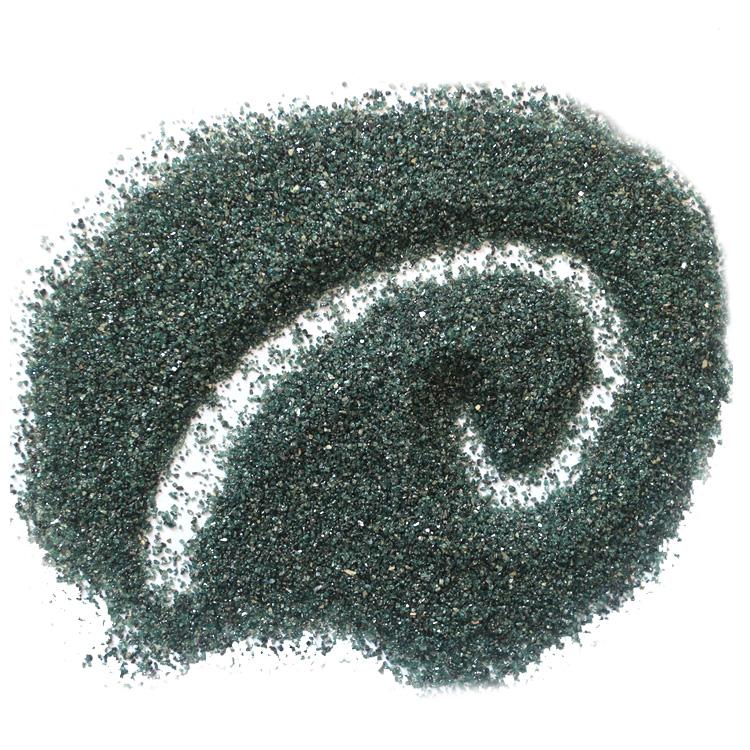
Silicon carbide used in industry is a synthetic material, commonly known as emery. Silicon carbide is one of the most commonly used non-oxide refractory raw materials in the field of refractories.
Silicon carbide SiC for conventional abrasive
Silicon carbide used in industry is a synthetic material, commonly known as emery. Silicon carbide is one of the most commonly used non-oxide refractory raw materials in the field of refractories. Clay-bonded silicon carbide, oxide-bonded silicon carbide, silicon nitride-bonded silicon carbide, recrystallized silicon carbide, reactive sintering silicon carbide and other products produced from silicon carbide
And amorphous refractories are widely used in blast furnaces, zinc smelting furnaces in metallurgy industry, kiln furniture in ceramic industry, etc.
Silicon carbide is available in black and green varieties. The content of SiO2 in the siliceous raw material is as high as possible and the impurity content is as low as possible when treating green silicon carbide; while the content of SiO2 in the production of black silicon carbide raw material can be slightly lower.
In the production of advanced silicon carbide refractories such as Si3N4-SiC, recrystallized SiC (R-SiC) and reactive sintered silicon carbide (Sisic), it is best to use shaped SiC sand. In the production of silicon carbide kiln furniture of the above materials, shaped SiC sand is widely used abroad, and the density, strength and oxidation resistance of kiln furniture have been significantly improved.
|
particle size range |
SiC> |
FC≤ |
Fe2O3 |
|
F4~F90 P12~P100 |
98.6 |
0.20 |
0.40 |
|
F100~F150 P120~P150 |
98.10 |
0.25 |
0.50 |
|
F180~F220 P180~P220 |
97.20 |
0.30 |
0.55 |
|
F230~F280 P240~P360 |
97.20 |
0.30 |
0.55 |
|
F320~F500 P400~P1000 |
97 |
0.35 |
0.60 |
|
F600~F800 P200~P1500 |
96.5 |
0.40 |
0.60 |
|
F1000~F1200 P2000~P2500 |
95.5 |
0.50 |
0.70 |
|
F4~F90 P12~P100 |
99.10 |
0.20 |
0.20 |
|
F100~F150 P120~P150 |
98.6 |
0.25 |
0.45 |
|
F180~F220 P180~P220 |
98.00 |
0.25 |
0.50 |
|
F230~F280 P240~P360 |
98.00 |
0.30 |
0.50 |
|
F320~F500 P400~P1000 |
97.50 |
0.30 |
0.50 |
|
F600~F800 P200~P1500 |
97.00 |
0.35 |
0.50 |
|
F1000~F1200 P2000~P2500 |
96.50 |
0.40 |
0.50 |
|
particle size range |
SiC%≥ |
FC%≤ |
Fe2O3%≤ |
|
F4~F90 P12~P100 |
98.10 |
0.25 |
0.50 |
|
F100~F150 P120~P150 |
97.60 |
0.30 |
0.60 |
|
F180~F220 P180~P220 |
96.70 |
0.35 |
0.65 |
|
F230~F280 P240~P360 |
96.70 |
0.35 |
0.65 |
|
F320~F500 P400~P1000 |
96.50 |
0.40 |
0.70 |
|
F600~F800 P200~P1500 |
96.00 |
0.45 |
0.70 |
|
F1000~F1200 P2000~P2500 |
95.00 |
0.55 |
0.80 |
|
F4~F90 P12~P100 |
98.00 |
0.25 |
0.25 |
|
F100~F150 P120~P150 |
98.10 |
0.30 |
0.50 |
|
F180~F220 P180~P220 |
97.50 |
0.30 |
0.60 |
|
F230~F280 P240~P360 |
97.50 |
0.35 |
0.60 |
|
F320~F500 P400~P1000 |
97.00 |
0.35 |
0.60 |
|
F600~F800 P200~P1500 |
96.50 |
0.40 |
0.65 |
|
F1000~F1200 P2000~P2500 |
96.00 |
0.45 |
0.65 |
Silicon carbide uses
1. Main use: used for wire cutting of 3-12 inch monocrystalline silicon, polycrystalline silicon, potassium arsenide, quartz crystal, etc. Solar photovoltaic industry, semiconductor industry, piezoelectric crystal industry engineering processing materials.
2. Chemical industry, abrasives industry, steel industry, etc.
Silicon carbide is also called moissanite. Among contemporary C, N, B and other non-oxide high-tech refractory raw materials, silicon carbide is the most widely used and most economical one, which can be called gold steel sand or refractory sand. At present, China's industrially produced silicon carbide is divided into two types: black silicon carbide and green silicon carbide, both of which are hexagonal crystals with a specific gravity of 3.20-3.25 and a microhardness of 2840-3320kg/mm2.
The alumina ball is also called the high aluminum accumulation of heat ball.High alumina refractory ball is based on bauxite as the mainly raw refractory material.Adding powder and additives and anchoring agent.After proportioning, molding and high sintering to make it.The production engineering of high alumina refractory ball is similar to that of high alumina refractory brick.It should be based on the properties of raw materials,high alumina refractory ball requires production conditions and other factors to determine.
Insulation castables are mainly made up of lightweight refractory aggregates, powders, and binder additives.
Corundum bricks are mainly used in iron-making blast furnaces and blast furnace hot blast furnaces, refining furnaces outside steel-making furnaces, sliding water heaters, glass melting furnaces and petrochemical industrial furnaces, etc.
Anchor bricks are anchor bricks for industrial kilns. The electric furnace roof is a furnace roof structure supported by metal hanging bricks and refractory bricks. Therefore, the leakage of reactive gas and hot gas in the furnace will damage the metal hanging parts, thereby causing furnace damage. roof collapse accident. Anchor bricks are also called hanging bricks and anchors.
Calcined alumina is a product obtained by calcining aluminum hydroxide at high temperature to partially or almost completely convert it into aAl2O2.
Acid resistant refractory gunning material is used for spraying of blast furnaces, hot blast stoves, hot blast pipes, flue protection layers, working layers, etc.
The chemical composition of bauxite is mainly Al2O3, SiO2, Fe2O3, TO2, accounting for about 95% of the total composition, and the secondary components are CaO, MgO, K2O, Na20, S, MnO2 organic matter and trace components Ga, Ge, etc.
Silica brick is an acidic refractory mainly composed of tridymite, cristobalite and a small amount of residual quartz and glass phases



